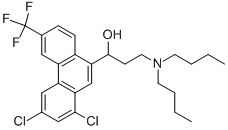HALOFANTRINE
|
|
HALOFANTRINE 속성
- 밀도
- 1.244±0.06 g/cm3 (20 ºC 760 Torr)
- 저장 조건
- 2-8°C
- 수용성
- 0.59mg/L(37℃)
안전
HALOFANTRINE C화학적 특성, 용도, 생산
개요
Halofantrine is an orally-active blood schizonticide reportedly highly effective in the treatment of fulcipurum malaria and other types of parasitemia. Cure rate is claimed to be over 95%.World Health Organization (WHO)
Halofantrine is an antimalarial introduced to medicine in 1982. It should be reserved for use in areas where multiple drug-resistant falciparum malaria is prevalent. Cases of serious cardiotoxicity have been reported.Antimicrobial activity
It inhibits erythrocytic stages of chloroquine-sensitive and chloroquine-resistant P. falciparum and other Plasmodium spp. in vitro at concentrations of 0.4–4.0 mg/L. It is more active than mefloquine and the combination of proguanil and atovaquone against P. falciparum, but less effective than mefloquine or chloroquine against P. vivax.원료
Resistance in P. falciparum has been reported in Central and West Africa, where it has been used widely. Cross-resistance with mefloquine has been reported in Thailand, where it has not been used.일반 설명
Structurally, halofantrine differs from allother antimalarial drugs. It is a good example of drug designthat incorporates bioisosteric principles as evidenced by thetrifluromethyl moiety. Halofantrine is a schizonticide and has no affect on the sporozoite, gametocyte,or hepatic stages. Both the parent compound and Ndesbutylmetabolite are equally active in vitro. Halfantrine’sspecific mechanism of action against the parasite is notknown. There is contradictory evidence that its mechanismranges from requiring heme to disrupting the mitochondria.There is a prominent warning that halfantrine can affectnerve conduction in cardiac tissue.Pharmaceutical Applications
A phenanthrene methanol, formulated as the hydrochloride for oral administration. Parenteral formulations are not available. The enantiomers have equivalent activity in vitro. Aqueous solubility is extremely low.Pharmacokinetics
Absorption shows high intra- and inter-subject variability and depends on co-administration with fats. Bioavailability is increased more than six-fold after a fatty meal or by lipidbased formulations. Bioavailability is significantly lower in patients with malaria than in healthy individuals. Peak plasma levels are variable and occur 3–6 h after administration. Unlike many other antimalarials, halofantrine is not concentrated by infected or uninfected erythrocytes. Distribution to lipoproteins is stereo-selective. About 20–30% of the dose is metabolized to an N-desbutyl derivative by cytochrome P450 (CYP) 3A4 and 3A5. The elimination half-life of the parent drug is generally 1–2 days and that of the metabolite 3 days. Little unchanged drug is excreted in urine.Clinical Use
Treatment of multidrug-resistant falciparum malariaIts use has been questioned due to the existence of safer alternatives.
부작용
Abdominal pain, diarrhea and pruritus are the most frequent. High doses (24 mg/kg) induce prolongation of the PR and QTc intervals; this is not stereo-selective. There are individual reports of fatal cardiac arrest and torsade de pointes. To reduce the risk of cardiac toxicity it should be taken on an empty stomach. It should not be administered with other antimalarials that have the potency to induce cardiac arrhythmias (mefloquine, chloroquine, quinine). Halofantrine has also been associated with intravascular hemolysis.신진 대사
Halofantrine is considered to be an alternative drug for treatment of both chloroquine-sensitive and chloroquine-resistant Plasmodium falci parum malaria, but its efficacy in mefloquine-resistant malaria may be questionable. The drug is metabolized via N-dealkylation to desbutylhalofantrine by CYP3A4. The metabolite appears to be several-fold more active than the administered drug.HALOFANTRINE 준비 용품 및 원자재
원자재
준비 용품
HALOFANTRINE 공급 업체
글로벌( 44)공급 업체
| 공급자 | 전화 | 이메일 | 국가 | 제품 수 | 이점 |
|---|---|---|---|---|---|
| career henan chemical co | +86-0371-86658258 15093356674; |
factory@coreychem.com | China | 29826 | 58 |
| Shaanxi Dideu Medichem Co. Ltd | +86-29-87569266 15319487004 |
1015@dideu.com | China | 2263 | 58 |
| ANHUI WITOP BIOTECH CO., LTD | +8615255079626 |
eric@witopchemical.com | China | 23556 | 58 |
| Dideu Industries Group Limited | +86-29-89586680 +86-15129568250 |
1026@dideu.com | China | 29220 | 58 |
| Dayang Chem (Hangzhou) Co.,Ltd. | 571-88938639 +8617705817739 |
info@dycnchem.com | CHINA | 52867 | 58 |
| GIHI CHEMICALS CO.,LIMITED | +8618058761490 |
info@gihichemicals.com | China | 49999 | 58 |
| 3B Pharmachem (Wuhan) International Co.,Ltd. | 821-50328103-801 18930552037 |
3bsc@sina.com | China | 15848 | 69 |
| Pure Chemistry Scientific Inc. | 001-857-928-2050 or 1-888-588-9418 |
sales@chemreagents.com | United States | 10194 | 62 |
| LGM Pharma | 1-(800)-881-8210 |
inquiries@lgmpharma.com | United States | 2127 | 70 |
| Shanghai Fuhe Chemistry Technology Co., Ltd. | 0086-21-67651709 |
cfx759@hotmail.com | China | 410 | 57 |
HALOFANTRINE 관련 검색:
베타-클로로나프탈렌
halofantrine hydrochloride
9-ETHYLPHENANTHRENE
1,6-DIMETHYLNAPHTHALENE
HALOFANTRINE
1-(2-NAPHTHYL)ETHANOL
3-(DIMETHYLAMINO)-1-(NAPHTHALEN-2-YL)PROPAN-1-OL
3-(NAPHTHALEN-2-YL)PROPAN-1-AMINE
3-(NAPHTHALEN-1-YL)PROPAN-1-AMINE
Halofantrine HCL
HALOFANTRINE IMPURITY C
HALOFANTRINE HYDROCHLORIDE MM(CRM STANDARD)
HALOFANTRINE HYDROCHLORIDE [3H(G)]
HALOFANTRINE HYDROCHLORIDE EPY(CRM STANDARD)
HALOFANTRINE IMPURITY C[1,3-DICHLORO-6-(TRIFLUOROMETHYL)PHENANTREN-9-YL]METHANOL EPY(CRM STANDARD)
9-N-PROPYLPHENANTHRENE
3,10-DIMETHYLPHENANTHRENE






